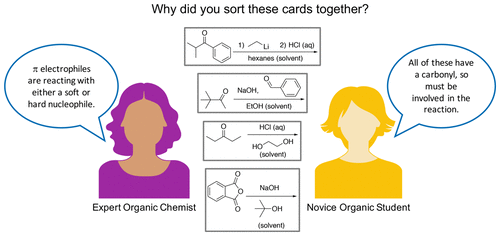当前位置:
X-MOL 学术
›
J. Chem. Educ.
›
论文详情
Our official English website, www.x-mol.net, welcomes your
feedback! (Note: you will need to create a separate account there.)
A Comparison of How Undergraduates, Graduate Students, and Professors Organize Organic Chemistry Reactions
Journal of Chemical Education ( IF 2.5 ) Pub Date : 2018-01-29 00:00:00 , DOI: 10.1021/acs.jchemed.7b00743 Kelli R. Galloway 1 , Min Wah Leung 1 , Alison B. Flynn 1
Journal of Chemical Education ( IF 2.5 ) Pub Date : 2018-01-29 00:00:00 , DOI: 10.1021/acs.jchemed.7b00743 Kelli R. Galloway 1 , Min Wah Leung 1 , Alison B. Flynn 1
Affiliation

|
To explore the differences between how organic chemistry students and organic chemistry professors think about organic chemistry reactions, we administered a card sort task to participants with a range of knowledge and experience levels. Beginning students created a variety of categories ranging from structural similarities to process oriented categories. Professors and more experienced graduate students created their categories only for process oriented reasons. Professors discussed different features of the reactions than the students did, suggesting that students need guidance and opportunities to develop skills to identify mechanistically relevant features in a reaction. More specifically, at the University of Ottawa, a transformed organic chemistry curriculum has been designed and implemented where students are first taught the language of mechanisms before learning about specific reactions. Then, students are taught reactions in order of their governing pattern of mechanism, rather than by functional group. We developed a card sort task to investigate how students perceive the organization of the reactions in the curriculum as well as to explore how graduate students and professors think about organic chemistry reactions. There were 25 cards designed with reactants and reagents for reactions taught within the first two semesters of organic chemistry. The card sort task is composed of two parts: first, participants are asked to sort 15 cards into categories; second, the participants are given 10 additional cards and asked to incorporate them into their existing categories. During the fall 2017 semester, second semester organic chemistry students (N = 16), organic chemistry graduate students (N = 10), and professors who either teach and/or conduct research in organic chemistry (N = 7) were interviewed using the card sort task. We analyzed the participants’ categories for cards that were frequently sorted together and the reasons they gave for creating the categories and then compared the findings across the different participant groups.
中文翻译:

大学生,研究生和教授如何组织有机化学反应的比较
为了探究有机化学学生和有机化学教授对有机化学反应的看法之间的差异,我们对参加者进行了一系列知识和经验水平的卡片排序任务。初学者创建了各种类别,从结构相似性到面向过程的类别。教授和经验丰富的研究生仅出于面向流程的原因才创建了类别。教授们讨论了与学生不同的反应特征,这表明学生需要指导和机会来发展技能,以识别反应中与机械相关的特征。更具体地说,在渥太华大学,已设计并实施了经过改造的有机化学课程,在学习特定反应之前,首先要教给学生机制语言。然后,将按照机制的控制方式而不是按功能组来指导学生反应。我们开发了一项卡片排序任务,以调查学生如何看待课程中反应的组织以及探索研究生和教授如何思考有机化学反应。在有机化学的前两个学期中,设计了25张卡片,其中包含用于反应的试剂和试剂。卡片分类任务由两部分组成:首先,要求参与者将15张卡片分类。第二,参与者将获得10张额外的卡片,并要求将其纳入现有类别。在2017年秋季学期,第二学期有机化学专业的学生(N = 16),有机化学研究生(N = 10)和教授和/或进行有机化学研究的教授(N = 7)使用卡片分类任务进行了采访。我们分析了经常分类的参与者卡片的类别以及他们创建类别的原因,然后比较了不同参与者组的发现。
更新日期:2018-01-29
中文翻译:

大学生,研究生和教授如何组织有机化学反应的比较
为了探究有机化学学生和有机化学教授对有机化学反应的看法之间的差异,我们对参加者进行了一系列知识和经验水平的卡片排序任务。初学者创建了各种类别,从结构相似性到面向过程的类别。教授和经验丰富的研究生仅出于面向流程的原因才创建了类别。教授们讨论了与学生不同的反应特征,这表明学生需要指导和机会来发展技能,以识别反应中与机械相关的特征。更具体地说,在渥太华大学,已设计并实施了经过改造的有机化学课程,在学习特定反应之前,首先要教给学生机制语言。然后,将按照机制的控制方式而不是按功能组来指导学生反应。我们开发了一项卡片排序任务,以调查学生如何看待课程中反应的组织以及探索研究生和教授如何思考有机化学反应。在有机化学的前两个学期中,设计了25张卡片,其中包含用于反应的试剂和试剂。卡片分类任务由两部分组成:首先,要求参与者将15张卡片分类。第二,参与者将获得10张额外的卡片,并要求将其纳入现有类别。在2017年秋季学期,第二学期有机化学专业的学生(N = 16),有机化学研究生(N = 10)和教授和/或进行有机化学研究的教授(N = 7)使用卡片分类任务进行了采访。我们分析了经常分类的参与者卡片的类别以及他们创建类别的原因,然后比较了不同参与者组的发现。











































 京公网安备 11010802027423号
京公网安备 11010802027423号